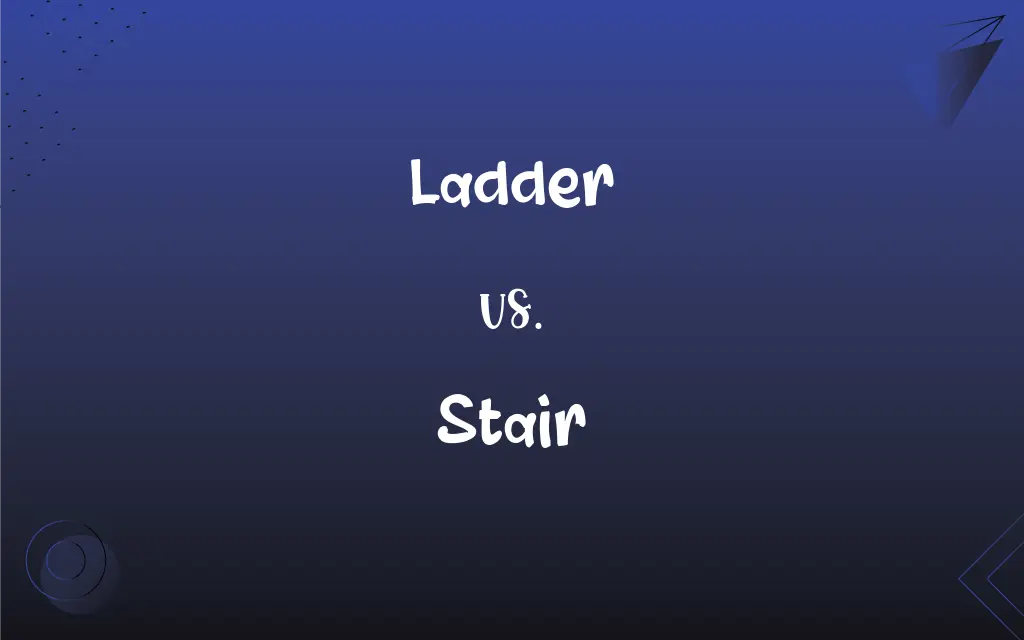Ladder vs. Stair: What's the Difference?
Edited by Aimie Carlson || By Janet White || Updated on October 7, 2023
A ladder is a portable climbing structure, usually consisting of two long sidepieces connected by rungs; stairs are a fixed set of steps connecting two different elevations.

Key Differences
A ladder and a stair are both means to ascend or descend between different levels or heights, but they differ significantly in structure, stability, and permanence. A ladder is typically portable, composed of two vertical supports connected by horizontal rungs or steps, usually used for reaching high places, climbing, or as a temporary access point. It's typically inclined and needs to be leaned against a stable surface. In contrast, stairs are a permanent, stable construction built into a building or structure, allowing individuals to move between floors or different elevations.
Ladders are versatile, allowing them to be moved and placed where needed, serving as a handy tool for reaching elevated areas, especially where space is limited or temporary access is required. They are commonly used in maintenance, construction, and emergency scenarios. Stairs, however, are integral parts of a building's architecture, providing a secure and convenient passage between different levels of a structure. Stairs are characterized by a series of steps, usually accompanied by a handrail, and are designed considering safety, convenience, and aesthetics.
While ladders are essential for tasks that require mobility and temporary elevation, their use is limited to those who can balance and climb, and they typically can't accommodate the traffic volume that stairs can. Stairs, being permanent, are suitable for continuous and frequent use, allowing multiple individuals to traverse between levels comfortably and safely, even carrying objects. Stairs are often designed to complement the architectural style of a building and may include additional features such as landings and balustrades.
In terms of safety, ladders demand caution as they are not as stable as stairs and might lead to accidents if not properly secured. They are not suitable for individuals with mobility issues. Stairs, due to their fixed nature and additional features like handrails, offer a higher level of safety and are more accessible to a wider range of individuals, including those with reduced mobility, making them a standard feature in buildings and structures.
Ladders and stairs are distinct structures serving as mediums to ascend or descend. A ladder, being portable and compact, provides temporary access, whereas stairs, being fixed and stable, offer a permanent solution for movement between different levels, designed to provide safety, accessibility, and aesthetic value in architectural contexts.
ADVERTISEMENT
Comparison Chart
Structure
Portable, usually inclinable, with rungs.
Permanent, fixed series of steps with a stable base.
Mobility
Can be moved and placed as per need.
Fixed in place, integral to the building’s structure.
Usage
Temporary access, suitable for limited usage.
Regular, frequent use to move between different levels.
Accessibility
Suitable for those who can balance and climb.
Accessible to a wider range of individuals.
Volume of Traffic
Cannot accommodate high traffic volumes.
Can accommodate multiple individuals simultaneously.
ADVERTISEMENT
Ladder and Stair Definitions
Ladder
A game played with dice and a board with numbered squares.
The children enjoyed a game of snakes and ladders.
Stair
A way of access consisting of a set of steps.
The back stair is less crowded.
Ladder
A means of ascending.
Education is a ladder out of poverty.
Stair
A passageway between levels by a series of steps.
He rushed down the emergency stair.
Ladder
A structure in knitting where a run has developed.
I have a ladder in my stocking.
Stair
One of a flight or series of steps for going from one level to another.
Watch your step; the stair is broken.
Ladder
A piece of equipment used for climbing, consisting of two vertical bars connected by horizontal rungs.
He climbed the ladder to reach the top shelf.
Stair
A series of steps or flights of steps for crossing to different levels.
The stair to the basement is steep.
Ladder
A series of ascending stages.
She moved up the corporate ladder quickly.
Stair
Often stairs A series or flight of steps; a staircase.
Ladder
An often portable structure consisting of two long sides crossed by parallel rungs, used to climb up and down.
Stair
One of a flight of steps.
Ladder
Something that resembles this device, especially a run in a stocking.
Stair
A single step in a staircase.
Ladder
A means of moving higher or lower, as in a hierarchy
Used his accomplishments as a ladder to success.
Stair
A series of steps; a staircase.
Ladder
A series of ranked stages or levels
High on the executive ladder.
Stair
One step of a series for ascending or descending to a different level; - commonly applied to those within a building.
Ladder
A fish ladder.
Stair
A series of steps, as for passing from one story of a house to another; - commonly used in the plural; but originally used in the singular only.
Ladder
An athletic workout in which one does progressively longer intervals followed by progressively shorter intervals.
Stair
Support consisting of a place to rest the foot while ascending or descending a stairway;
He paused on the bottom step
Ladder
One of the intervals in such a workout.
Ladder
To run, as a stocking does.
Ladder
A frame, usually portable, of wood, metal, or rope, used for ascent and descent, consisting of two side pieces to which are fastened rungs (cross strips or rounds acting as steps).
Ladder
(figuratively) A series of stages by which one progresses to a better position.
Ladder
(figuratively) The hierarchy or ranking system within an organization, such as the corporate ladder.
Ladder
A length of unravelled fabric in a knitted garment, especially in nylon stockings; a run.
Ladder
In the game of go, a sequence of moves following a zigzag pattern and ultimately leading to the capture of the attacked stones.
Ladder
To arrange or form into a shape of a ladder.
Ladder
To ascend (a building, a wall, etc.) using a ladder.
Ladder
Of a knitted garment: to develop a ladder as a result of a broken thread.
Oh damn it, I've laddered my tights!
Ladder
To close in on a target with successive salvos, increasing or decreasing the shot range as necessary.
Ladder
A frame usually portable, of wood, metal, or rope, for ascent and descent, consisting of two side pieces to which are fastened cross strips or rounds forming steps.
Some the engines play,And some, more bold, mount ladders to the fire.
Ladder
That which resembles a ladder in form or use;
Lowliness is young ambition's ladder.
Ladder
Steps consisting of two parallel members connected by rungs; for climbing up or down
Ladder
Ascending stages by which somebody or something can progress;
He climbed the career ladder
Ladder
A row of unravelled stitches;
She got a run in her stocking
Ladder
Come unraveled or undone as if by snagging;
Her nylons were running
FAQs
Are stairs built into a structure?
Yes, stairs are typically permanent and are built into a structure.
Can ladders be used for emergency exits?
Yes, ladders can be used for emergency exits, especially in confined spaces.
Do stairs have handrails?
Typically, stairs do have handrails for added safety.
Can a ladder have different types and designs?
Yes, ladders come in various types and designs suitable for different needs.
Do all buildings have stairs?
Most multilevel buildings do have stairs, but single-level buildings may not.
Do ladders need to be leaned against a stable surface?
Most ladders need to be leaned against a stable surface, but some have a self-supporting structure.
Can stairs serve as a means of exercise?
Yes, climbing stairs is a common and effective form of exercise.
Is a ladder portable?
Yes, a ladder is usually portable and can be moved as needed.
Are stairs safer than ladders?
Generally, stairs are considered safer due to their stability and the presence of handrails.
Is a ladder a temporary solution for ascending?
Yes, ladders often provide a temporary solution for reaching elevated places.
Can stairs be external to a building?
Yes, stairs can be both internal and external to a building.
Is a ladder suitable for frequent traffic?
No, ladders are not suitable for frequent or high-volume traffic.
Are stairs designed considering aesthetics?
Yes, stairs are often designed to complement a building’s architecture and aesthetics.
Are ladders used in construction and maintenance?
Yes, ladders are widely used in construction, maintenance, and other tasks requiring elevation.
Are ladders usually inclinable?
Yes, ladders are usually inclinable and should be inclined at a safe angle when in use.
About Author
Written by
Janet WhiteJanet White has been an esteemed writer and blogger for Difference Wiki. Holding a Master's degree in Science and Medical Journalism from the prestigious Boston University, she has consistently demonstrated her expertise and passion for her field. When she's not immersed in her work, Janet relishes her time exercising, delving into a good book, and cherishing moments with friends and family.
Edited by
Aimie CarlsonAimie Carlson, holding a master's degree in English literature, is a fervent English language enthusiast. She lends her writing talents to Difference Wiki, a prominent website that specializes in comparisons, offering readers insightful analyses that both captivate and inform.































































